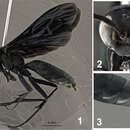Description
provided by Zookeys
Body length 2.00 cm; fore wing 1.82 cm; maximum wing width 0. 57 cm.
Coloration. Integument black with pale yellow maculation on inner margin of eyes; body covered with pubescence with bluish-green metallic reflections (Fig. 1); clypeus, antennae, labial and maxillary palpi black; wings black with weak purple reflections; veins dark castaneous; legs with greenish-purple-blue reflections.
Head. Head wide; TFD 1.2 × FD; MID 0.7 × FD; punctuation conspicuous, small, shallow. Ocelli in obtuse angle; lateral ocelli closer to each other than to compound eyes; POL 0.8 × OOL. Mandible narrow, base about 2.0 × wider than apex, with two sharp apical teeth; 1/3 of base covered by thin copper pubescence. Clypeus undifferentiated from frons, flat, bilobed, apical median margin invaginated (Fig. 2); clypeal lobes rounded (Fig. 2); LC 0.4 × WC. Labrum partially exposed. Maxillary beard not present. Flagellum elongate; length of second flagellomere 2.5 × width; ratio of the scape, pedicel, and flagellomeres 1-2 11:4:14:15; WA3 0.5 × LA3; LA3 0.4 × UID; scape with erect setae on internal margin. Torulus circular, antennal scrobe large.
Mesosoma. Pronotum not elongated (Fig. 1), width 3.3 × length; posterior margin arched, anterior margin slightly invaginated medially; propodeal disc with thin-shallow median sulcus. Notauli shallow, present on 1/5 of anterior margin. Postnotum striated. Propodeum with punctures small, almost inconspicuous under setae; propodeal disc covered with short-apressed pubescence, setae equally abundant on propodeal disc; propodeal disc slightly elevated medially, edges of disc rounded. Wing elongate; maximum width 0.3 × length; third submarginal cell about as long as second submarginal cell; second recurrent vein straight, meeting third submarginal cell half distance from base to apex of cell (Fig. 1). Fore tibia with short, sharpened spines, posterior edge angulated. Front tarsal claw bifid, mid and fore claw dentate. Tarsi spinose.
Metasoma. Metasoma covered by short, scale-like setae. Sternum 7 covered by thick, long setae, marginal setae longer than remaining setae, apex of setae sinuous and dilated (Fig. 3).
Genitalia. (Figs 4–6) Parapenial lobe bifid; lobe wide, short, almost shield-like; outer apex lanceolate, higher than inner apex; inner apex rounded, broad. Dorsal lobe of digitus slightly longer than edeagus, apex wide, rounded, with small extension ventrally; ventral lobe of digitus, short, length 0.3 × paramere length, spatulate, base with long, thin setae (Figs 4, 5). Aedeagus short, total length 0.6 × length of paramere + gonobase, split, lateral margins rolling inwards, apex rounded (Figs 4, 5). Paramere as long as aedeagus, constricted on base, wide apically; apex lanceolate, covered with long setae, inner face flat, outer rounded; setae long, longer marginally, apex dilated. Subgenital plate elongate, wide; apex narrower, rounded; apical margin of apex polished, glabrous; abundant setae, long, thin along entire length (Fig. 6).
- license
- cc-by-3.0
- copyright
- Cecilia Waichert, James P. Pitts
- bibliographic citation
- Waichert C, Pitts J (2013) Two new species of Abernessia Arlé (Pompilidae, Ctenocerinae) ZooKeys 353: 77–85
- author
- Cecilia Waichert
- author
- James P. Pitts

